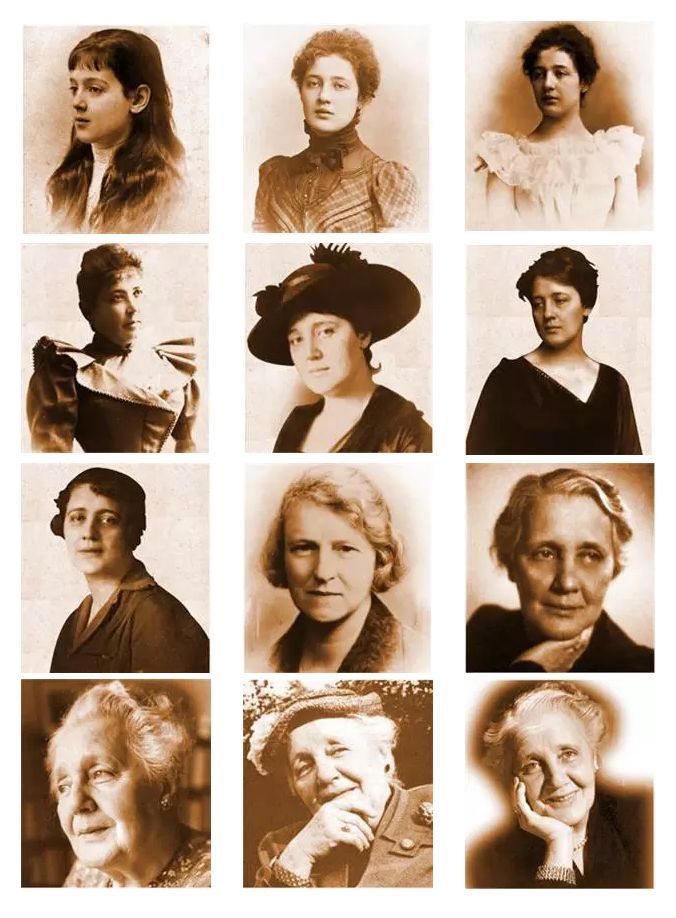IPA精神分析辞典:投射性认同
Gary Schlesinger、Florence Guignard、Ricardo Spector、Arne Jemstedt 文
Mints 译

I. INTRODUCTION AND DEFINITIONS
1、导言和定义
Projective identification, a concept introduced by Melanie Klein in 1946, is both a primitive defense mechanism as well as a fundamental mode of unconscious communication with oneself and with the world. It allows the self to disavow unwanted experience while affording a modicum of control over the object of the projection.
投射性认同(Projective identification)是梅兰妮·克莱因(Melanie Klein)于1946年提出的概念,它既是一种原始的防御机制,也是一种与自己和世界进行无意识交流的基本模式。它允许自我在(通过投射性认同)承受着对客体进行温和控制的时候,否认(disavow)自己不想要的体验。
Projective identification is a twofold unconscious movement that ignores the boundaries between the Self and the other and deals mainly with part-objects and parts of the Self. By projecting them into another person, first real, then also fantasized, the subject – first, the infant – evacuates – first, into the mother – painful body experiences, death anguish and other emotions and feelings that overwhelm his/her capacities to contain them within him/herself.
投射性认同是一种双重无意识运动,它忽略了自我和他人之间的边界,主要用于处理部分客体(part-objects)和自我的一些部分。通过将它们投射到另一个人身上,首先是真实的,然后是幻觉,首先是主体,即,婴儿排出(evacuation)的部分——投射进入母亲——痛苦的身体体验、对死亡的极度痛苦和其他情绪(emotions)和感受(feelings),这些情绪和感觉压倒了他/她在体内涵容它们的能力。
However, such a denial does not prevent the subject from keeping unconscious links with these expelled objects and parts of the Self; s/he also identifies him/herself with characteristics of the person into which s/he projected these elements.
然而,这种否认并不能阻止主体与这些被驱逐的部分客体和部分自我保持无意识的联系;他/她也认同这位带着他/她投射之特征的人。
Melanie Klein added projective identification to the first set of defenses – splitting, denial and idealization – that she had sorted out and specially dealt with in her 1946 paper, because she observed that it appeared simultaneously with these in the infant.

Melanie Klein将投射性认同添加到了第一套防御机制(分裂、否认和理想化)中,这在她1946年的论文中进行了整理和特别报道,因为她观察到投射性认同与婴儿的这些防御同时出现。
Projective identification is made of two main psychoanalytic concepts – projection and identification. However, apart from the fact that both are unconscious psychic movements, these two concepts do not have the same level of complexity:
投射性认同由两个重要的精神分析概念组成——投射(projection)和认同(identification)。然而,除了两者都是无意识的精神运动之外,这两个概念的有着不同的复杂性:
-Projection-and-introjection are the basic mechanisms required for a psychic life to exist, in the same way as inspiration-and-expiration are the necessary mechanisms of breathing in biological life.
——投射和内摄(introjection)是精神生活存在所需的基本机制,就像吸气和呼气是物生物生活呼吸的必要机制一样。
-Identification is a much more complex process, made of a mosaic of relational micromovements, and never achieved.
——认同这是一个更复杂的过程,由关系的微观运动拼凑而成,而且从未实现。
Melanie Klein认为投射性认同从出生到死亡都发挥着作用,在发展过程中逐渐形成了更加清晰和有意识的关系和沟通方式。
Projective identification is a hybrid and dynamic concept that applies to intrapsychic life as well as to interpersonal dynamics and economy (Guignard, 2017-2020). It enhances the importance of a first object fit for the newborn to have good enough relations: the helplessness and pre-maturity of the human baby make it necessary for him/her to get from the outside (from the mother) a fundamental means of communication, in order to have a grip on a ruthless reality. The newborn needs to meet the caring and thinking capacities in the mother in order to welcome and try to soothe those projected parts of him/her.
投射性认同是一个混合的(hybrid)动态概念,适用于内在精神生活以及人际动力学和经济动力学(Guignard,2017-2020)。它强调了第一个适合(fit for)新生儿的客体(和婴儿之间有着足够好的关系)的重要性:人类婴儿的无助和早熟使得他/她有必要从外部(从母亲那里)获得一种基本的沟通方法,以便掌控无情的现实。新生儿需要遇见(meet)母亲的关怀和思考能力,以便欢迎并试图抚慰他/她的那些投射。
Projective identification cannot be understood separately from “introjective identification”, a concept rarely made explicit in clinical descriptions. Together, they constitute the feeling of identity of a person, a feeling always in motion and never achieved.
投射性认同不能与“内摄性认同”分开理解,后者是一个在临床描述中很少详细描述的概念。它们共同构成了一个人的认同(identity)感,一种始终处于运动状态且从未实现的感觉。
II. HISTORICAL EVOLUTION OF THE CONCEPT
2、投射性认同概念的历史演变
Projective identification developed as a combination of Freud’s (1915 – “Instincts and their vicissitudes”) concept of projection – which he viewed as a means for the ego to rid itself of painful, threatening mental contents – and of his concept of identification. In his papers on metapsychology (eg 1917, 1923) Freud wrote that identification is the first form of object relation to appear at birth. It could be said that his 1914 essay on narcissism resulted in such an insight about a common psychic movement that installs simultaneously object relation and identification.
投射性认同形成于弗洛伊德《本能及其变迁》(1915C)中的投射概念(他认为投射是自我摆脱痛苦的、威胁性的心理内容的一种手段)和他的认同概念的结合。弗洛伊德在他的元心理学的论文(例如1917、1923)中写道,认同是出生时出现的第一种客体关系形式。可以说,他在1914年发表的《论自恋》中产生了这种洞见——同时装载了客体关系(object relation)和认同(identification)的常规精神运动。
In 1938, shortly before his death, Freud clarified the primitive defense mechanisms of splitting, denial and idealization. In particular, he stressed the difference between the violence of the primal defenses compared to the secondary ones – linked to the secondary repression. By studying these defenses in relation to perversions, he focused on their pathology, not on their structure.
1938年,在他去世前不久,弗洛伊德阐明了分裂、否认和理想化的原始防御机制。他特别强调了猛烈的原始防御与次级防御之间的区别,后者与次级压抑有关。通过研究这些与异常(心理)有关的防御机制,他把重点放在了它们的病理学上,而不是它们的结构上。
Melanie Klein’s concept of projective identification might be considered as having its roots in Freud’s considerations mentioned above. However, one should add to it Klein’s discoveries of the role of splitting in the world of objects – not only of the Ego, as Freud described it – that gave rise to the rich and complex universe of part-objects relations and identifications.
人们认为,梅兰妮·克莱因的投射性认同概念可能源于上文所述的弗洛伊德之考量。然而,我们应该再加上克莱因发现的分裂(splitting)在客体世界中的作用——不仅仅是如同弗洛伊德所描述的自我——这种分裂产生了丰富而复杂的部分客体关系和认同的宇宙。
Projective identification addresses psychic objects projected – transferred – onto various people, the first of which is obviously the mother in the beginning of life, or her substitute, first as a part-object – “the breast” – then, as a total object – the person of the mother.
投射性认同指的是投射到——转移(transferred)到——不同的人身上的精神客体,这些客体,第一个显然是生命开时的母亲,或她的替代者,首先是作为部分客体——“乳房”——然后是作为整体客体(total object)——母亲这个人。
In 1946, Melanie Klein viewed projective identification as an intrapsychic means by which the infant relieves itself of unwanted affects, objects and parts of the self and a mechanism by which it takes control of the mother in [unconscious] phantasy. She also made clear that these projected aspects could be either good or bad. She introduced the notion that projective identification, fueled by unconscious envy, serves to destroy – once again in phantasy – the object of envy. As Klein viewed the infant’s project as keeping the bad out and the good in, she noted that projective and introjective identification go hand in hand.
1946年,梅兰妮·克莱因将投射性认同视为一种内在精神方式,婴儿通过这种方式缓解(relieves)不想要的一些情感,客体和部分自我,以及通过这种机制[在无意识中]控制母亲的幻觉。她还明确表示,这些被投射的诸多部分可能是好的,也可能是坏的。她引入了一个概念,即投射性认同在无意识嫉妒(envy)的推动下,再次在幻觉中摧毁了嫉妒的客体。克莱因认为婴儿的投射是把坏的东西挡在外面,把好的东西放在里面,她指出投射性认同和内摄性认同是相辅相成的。
She observed that a pathological use of projective identification keeps the subject in an illusory phantasy of being able to avoid the long and painful process of mourning described by Freud (1915) and thus – in the Kleinian framework – impede the move from the paranoid-schizoid position to the depressive position. Klein thought of projective identification as an unconscious phantasy – both the ‘projection’ and the ‘identification’ parts are unconscious. The object or part-object who is the recipient of the projection does not have to be present and does not have to know about the projection at all. Klein stressed the fact that this mode of functioning – splitting / denial / idealization / projective identification – erases the boundary between external reality and psychic reality and allows the subject to gain power – in phantasy – over the whole or part of an external person or of an internal object. The unconscious phantasy of projective identification is a powerful process. It will always have real effects on the mind of the person projecting (who will have lost part of himself and may for example feel very certain and righteous or may feel very empty after a massive projection). And it can under certain circumstances have real effects on the person who is the recipient.
她观察到,病理性地使用投射性认同使得主体处于一种幻觉(phantasy)中,即,能够避免弗洛伊德(1915年)描述的漫长而痛苦的哀伤过程,从而——在克莱因框架中——阻碍了从偏执型精神分裂心位向抑郁心位的移动。克莱因认为投射性认同是一种无意识的幻觉——“投射”和“认同”的部分都是无意识。接受了投射的客体或部分客体不必在场,也根本不必知道这些投射。克莱因强调,这种功能模式——分裂/否认/理想化/投射性认同——抹去了外部现实(external reality)和精神现实(psychic reality)之间的边界,并允许主体获得力量—在幻觉中—驾驭(over)全部或部分的外在的人(external person)或内部客体(internal object)。投射性认同的无意识幻觉是一个强大的过程。它总会对被投射者的心智产生真正的影响(被投射者会失去部分自我,可能会感到非常确定和正直,或者在大量投射后可能会感到非常空虚)。在某些情况下,它会对接收者产生真实的影响。
Wilfred Bion expanded Klein’s notion of “projective identification as a defensive phantasy” to include its function as a normal, pre-verbal form of communication that actually occurs between mother and infant. He felt that these early communicative experiences were extremely consequential and saw the development of the capacity to think as dependent on how mother and infant are able to adjust to one another. From 1962 on (Bion 1962a, 1962b) he describes how the child’s development of the capacity to think (i.e. alpha function) is dependent on primitive sensorial experience (beta elements) being managed and thus transformed in the mother-child relationship. Bion’s development of the theory of mind was revolutionary in considering that the infant’s capacity to think about and thus manage experience is dependent on the relationship with the alpha function of another human being, i.e., the mother’s.

比昂(Wilfred Bion)扩展了Klein的“投射性认同是一种防御性幻觉”的概念,将其作为一种正常的、前言语的,的确发生在母婴之间的沟通形式。他认为这些早期沟通经验非常重要,他认为思考能力的发展取决于母亲和婴儿如何适应彼此。从1962年开始(Bion 1962a、1962b),比昂描述了儿童思维能力(即阿尔法功能)的发展如何依赖于原始感官经验(贝塔元素)的管理,从而在母婴关系中转化。比昂考虑到婴儿思考和管理经验的能力取决于他/她和另一个人的阿尔法功能的关系,即母亲的阿尔法功能,这对心智理论的发展而言,是革命性的。
Along the lines of Kantian philosophy, Bion considered that thinking is called into existence to cope with thoughts, that thinking is a development forced upon the psyche by the pressure of experience and not the other way around.
按照康德哲学的思路,比昂认为,被称之为存在的思考(thinking)是为了应对思想(thoughts),思考的发展,建立加载在心理的经验之上,而非其他的东西。
Bion believed that, based on the need to survive, the baby has an inbuilt expectation (a preconception) of the existence of a satisfying breast and when she/he experiences this satisfaction, both physically and emotionally (a realization) she/he begins to build an as yet unnamed concept (a conception) which becomes the basis for healthy development. As the baby will inevitably experience distress, the capacity to tolerate frustration will facilitate the development of the capacity to ‘think’, which in turn helps the baby to manage the frustration. This process is dependent on the mother’s ability to “contain” the baby’s projections of “pain and anguish” into her. (see entry CONTAINMENT: CONTAINER-CONTAINED)
比昂认为,基于生存的需要,婴儿对于满足的乳房的存在有一种内在的期望(一种先占观念 preconception),当她/他体验到这种满足时,无论是在身体上还是情感上(一种意识/领悟),她/他开始建立的一个尚未命名的概念concept(构思conception),这个概念成为了健康发展的基础。由于婴儿不可避免地会经历痛苦,忍受挫折的能力将促进“思考(think)”能力的发展,反过来又有助于婴儿管理挫折。这一过程取决于母亲是否有能力“涵容”婴儿投射进她体内的“痛苦和极度痛苦”的投射物。(参见词条涵容:涵容者与被涵容者)
Under the best of circumstances, the personalities of both mother and infant are able to adapt to one another so that the infant, with its rudimentary reality sense, is able to produce behaviors reasonably calculated to arouse in the mother feelings that the infant wishes to get rid of. The mother can then process those feelings, during what Bion calls their sojourn in her, returning them to the infant in digestable form by means of the mother’s ministrations. Her ability to “contain” the toxic material projected onto her relies on her capacity for reverie, i.e. her ability to “think” or “dream” about the projecting subject. Reverie is a factor of the mother’s alpha-function (Bion, 1962b) and the child’s repeated experience of this process enables him/her to develop thougths and a thinking mind capable of managing emotional distress.
在最好的情况下,母亲和婴儿的性格都能够相互适应,这样,婴儿凭借其初步的(rudimentary)现实感,有能力产生各种行为,这些行为一再唤起妈妈感受到婴儿想要去除的这些情感。然后,母亲可以处理这些情感,比昂说,这些情感寄居(sojourn)在妈妈内心,在其此间,通过母亲的照料(ministrations)通过可消化的形式将它们返回给婴儿。她“涵容”投射到自己身上的有毒物质的能力取决于她的遐想(reverie)能力,即她“思考”或“掌梦”投射的客体的能力。遐想是母亲阿尔法功能的一个因素(Bion,1962b),而且,孩子对这个过程的反复体验,能够让他/她发展出能够应对管理情绪困扰的思想(thougths)和想法。
In contrast to this situation, when the infant’s pre-conception of a satisfying breast is repeatedly disappointed with a negative realization (i.e. deprivation), a bad object (no breast) is formed. If the mother is unable to receive and contain the baby’s defensive negative projections, or if the infant has a low tolerance for frustration, the bad object, fit only for evacuation (Klein’s projective identifcation) will remain in place. For Bion, the ways in which mother and infant manage these projective identifications will determine the developing child’s capacity to regulate affect and maintain effective ego functioning. Bion’s conceptual model has had vast implications for the psychoanalytic process and for our understanding and use of the countertransference in the clincal setting.
与这种情况相反,当婴儿的先占观念因为负面的意识realization(即剥夺)反复地对满意的乳房而失望时,就会形成一个(没有乳房)的坏客体。如果母亲无法接收和涵容婴儿的防御性负面投射,或者,如果婴儿忍受挫折的能力较低,那么,这个坏客体,则只适合排出(克莱因的投射性认同)以保留原位。对于比昂来说,母亲和婴儿管理这些投射性认同的方式将决定儿童调节情感和维持有效自我功能之能力的发展。比昂的概念模型对精神分析过程以及我们在临床环境中对反移情的理解和使用有着巨大的影响。
Returning to Melanie Klein, she described – as mentioned above – projective identification as closely linked to the primal set of defenses. She thus opened up the exploration of the vast field of part-object relationships and, in addition to her own contributions to the study of the pathology of these defenses, she was then able to give a more realistic and complete picture of the psychic world, both of the infant and of the unconscious functioning all lifelong.
回到Melanie Klein,她指出——如上所述——投射性认同与最初的那套防御机制密切相关。因此,她开启了部分客体关系这一广阔领域的探索,除了她自己对这些防御机制的病理学研究所做的贡献外,她还能够给出一个更真实、更完整的精神世界的画面,包括婴儿一生的无意识功能景象。
Today, it is possible to be more precise from a conceptual point of view: due to the heterogeneous complexity of the concept described above, projective identification has to be considered as a primitive psychic function produced by the first set of defenses. Projective identification is the means of communication par excellence of the Preconscious. From a conceptual point of view, it is inappropriate to mix up the unconscious fantasies arising from the various situations of projective identification with the function that allows them to appear.
今天,从概念的角度来看,可能更精确的说:由于上述各种各样复杂的概念,投射性认同必须被视为第一组防御产生的原始心理功能。投射性认同是前意识(Preconscious)的卓越沟通方式。从概念的角度来看,把投射性认同的各种情境中产生的无意识幻觉与允许它们出现的功能混为一谈是不合适的。
At the beginning of life, such a function fills a vital aim: to allow the helpless newborn to survive and to have a relationship with his first environment. From birth to death, projective identification is used to maintain the feeling of existence and of object cathexis, in particular by internalizing the absent or lost object. It is the central tool in any situation of mourning. In melancholia, the function of projective identification has been totally destroyed by the attacks of the Superego against the Ego and the Id.
在生命之初,这样的功能充满了一个至关重要的目标:允许无助的新生儿生存下来,并与第一个环境建立关系。从出生到死亡,投射性认同被用来维持存在和客体贯注的感受,尤其是通过内化缺席或丧失的客体。它是任何哀悼场合的核心工具。在忧郁症中,投射性认同的功能被超我(针对自我和本我)的攻击彻底摧毁。
Being a function of the mind that develops according to the characteristics of each person, projective identification may result in empathy for, – or in a paranoid grip on, – the object involved; a rich communication of feelings and thoughts – or a dictatorial submission of one protagonist to the other; an increase of discoveries in the common field of interest of the two persons – or a phobic flight from the relationship by the subject to avoid any proximity with the elements he/she has projected into his/her protagonist.
投射性认同是一种根据每个人的特征发展起来的思维功能,它可能会导致:对所涉及的客体产生共情,或者产生偏执的掌控;情感和思想的丰富交流——或者一个独裁者(dictatorial)对另一个主要人物(protagonist)的屈服;增加两人在共同感兴趣的领域的探索——或,主体出于恐惧逃离关系,以避免接近他/她投射到他/她的主要任务体内的元素。
Klein’s discovery of projective identification is an answer to the question of the object in the primary narcissistic state: this state can no longer be regarded as objectless, since virtually any split part of the Ego may be combined with any split part of an object, either external or internal. Freud (1921) had already observed that narcissistic identifications were based upon a single detail of the person unconsciously chosen as a model. His remark about the necessity to mourn every detail of the lost object to complete a real process of mourning (Freud, 1917) enhances the importance of the link created by projective identification, both in object relations and in the feeling of identity.
克莱因发现的投射性认同,回答了处于原始自恋状态的客体的问题:这种原始自恋状态不能再被视为无客体状态,因为事实上,自我的任何分裂部分都可能与客体的任何分裂部分相结合,无论是外部的还是内部的。弗洛伊德(1921)已经观察到自恋性认同( narcissistic identifications)单一的细节,这个人无意识的充当了自己的榜样。他指出,为了完成一个真正的哀悼过程,有必要详细的哀悼每一个丧失客体的细节,哀悼过程增强了投射认同在客体关系和认同感中所创造的连接的重要性。心理学空间网 陈明翻译 转载请保留
II. A. Further British and European Contributions
2.1 英国和欧洲的进一步贡献
Impacted by Bion’s development of the concept of projective identification and his model of the development of the capacity for thinking, Esther Bick and Donald Meltzer utilized their experience in the field of infant observation and the clinical treatment of autistic children to discern, delineate and differentiate an even more elemental maneuver, related to but not the same as projective identification. They coined the term adhesive identification (later termed adhesive identity) and differentiated this more primitive defensive operation from projective identification.
受比昂投射性认同概念和思维能力模型之发展的影响,Esther Bick和唐纳德·梅尔泽(Donald Meltzer)利用他们在婴儿观察和自闭症儿童临床治疗领域中的经验辨别,勾勒(delineate)并区分的更基本的操纵,这些操纵与投射性认同有关,但又和投射性认同不同。他们创造了“粘附性认同(adhesive identification)”(后来被称为粘附性同一性adhesive identity)一词,并将这种更原始的防御操作与投射性认同区分开来。
Esther Bick (1968, 1986) delineated an elemental type of narcissistic identification, which developmentally precedes that which is implied in Klein’s theory of projective identification. She hypothesized that very young babies may initially experience the absence of boundaries sufficiently capable of holding together their mental and emotional contents, not yet completely distinguishable or differentiated from their bodily contents. Bick proposed the notion of a “psychic skin”, which ideally serves to passively bind together the experiences or parts of the nascent self. The development of this “psychic skin” occurs through experiences of continuous interaction between a physically and emotionally “holding” and mentally “containing” mother, and the surface of the infant's body as a sensory organ. This notion is one which Freud (1923) alluded to when he suggested that “the ego is first and foremost a bodily; it is not merely a surface entity, but is itself the projection of a surface” (p. 26).

Esther Bick(1968, 1986)勾勒了自恋性认同的一种基本类型,自恋型认同在发展上先于克莱因在投射认同理论中暗示的。她假设,非常小的婴儿最初可能会体验到边界的缺失,这个边界足以能够将其心智和情感的内容抱持在一起,但尚未完全辨别(distinguishable)或区分(differentiated)他们的身体内容。Bick提出了“心理皮肤(psychic skin)”的概念,在理想情况下,它有助于被动地将最初的(nascent)(上述)诸多体验或诸多部分自我绑在一起。这种“心理皮肤”的发育发生在母婴之间的持续互动经验之中,即,在身体和情感上“抱持(holding)”,心智上“涵容(containing)”的母亲,以及作为感觉器官的婴儿身体表面之间的持续互动经验。弗洛伊德(1923)在提出“自我首先是,而且最重要的是一个身体;它不仅是一个表面实体,而且本身是一个表面的投射。”(第26页)。
Bick (1968) further hypothesized that “later, identification with this [psychic skin] function of the object supersedes the unintegrated state and gives rise to the [ph]antasy of internal and external spaces” (p. 484). She forwarded the idea that this phantasy of space is the essential basis for the normal adaptive splitting and projection necessary to the processes of idealization and separation described by Klein. However, Bick warned that
Bick(1968)进一步假设,“后来,对客体的这种[心理皮肤]功能的认同取代了不整合的状态,并产生了对内部和外部空间的幻觉”(第484页)。她传达这样一个观点,即,这种空间幻觉是(克莱因所描述的理想化和分离过程所必需的)正常适应性分裂和投射的基本依据。然而,Bick告诫道:
“… until the containing function has been introjected, the concept of a space within the self cannot arise … [and] construction of an [internal containing] object … [will be] impaired… Faulty development of this primal skin function can be seen to result either from defects in the adequacy of the actual object or from fantasy attacks on it, which impair introjection. Disturbance in the primal skin function can lead to a development of a ‘second skin’ formation through which dependence on the object is replaced by a pseudo-independence, by the inappropriate use of certain mental functions, or perhaps innate talents, for the purpose of creating a substitute for this skin container function.” (p 484)
“……在引入涵容功能之前,无法产生自我内部空间的概念……[和]一个[内在涵容]客体的构造…[这将是]受损的……可以认为,这种原始皮肤功能的发育缺陷,或是来自于实际客体的胜任缺陷,或是来自于对它的幻觉攻击,从而削弱了内摄性。原始皮肤功能的紊乱可导致发展形成“第二皮肤(second skin)”,通过第二皮肤,对客体的依赖被伪独立性取代,伪独立性通过不适当地使用某些心智功能,或者先天天赋,以创造一种替代这种皮肤容器功能的替代品。”(p484)
Donald Meltzer's work with Bion's theories led him to propose a classification of the pathology of projective identification, according to whether the disorders are primarily in the field of projection or mainly in that of identification (Meltzer, 1986).

唐纳德·梅尔泽用比昂的理论进行工作,他根据疾病主要是在投射领域还是在认同领域(Meltzer,1986)提出了投射性认同的病理学分类。
Pathology of projection has to do with the way the inner world of the object is fantasized; here we are in the field of phobias, especially agoraphobia and claustrophobia. Fantasies about the nature and quality of the atmosphere that could prevail within the object are also found in some psychotic states of confusion, especially those observed during adolescence. Meltzer also mentions the syndrome of distorted perception, which he calls the “delusion of clarity of insight”, namely, the conviction of knowing exactly what another person is thinking.
投射的病理学与客体内心世界的幻想方式有关;我们在恐怖症领域,尤其是广场恐怖症和幽闭恐惧症(可以看到)。在一些精神错乱的状态中,尤其是在青春期(个案中)观察到的那些状态中,也发现了客体内部可能盛行的幻想气氛的性质和质量。梅尔泽还提到了感知扭曲综合征(the syndrome of distorted perception),他称之为“洞见清晰的错觉”,即,确切的知道另一个人在想什么的信念。
The most common pathology of identification consists in an immediate appropriation of the object’s qualities. Hysterical conversion is the classic example of it is, but it is also present in manic-depressive psychosis, in hypochondria and in states of pseudo-maturity, where the subject may be stuck in his projective identification with an idealized object, without proceeding further to a work of mourning of the latter in order to build, first, an intermediate state of heterogeneous hyper maturity, then, to then reach a balanced ideal of the Ego.
最常见的病理学认同在于对客体性质的直接挪用(appropriation)。歇斯底里式的转换就是一个典型的例子,但它也存在于躁狂-抑郁性精神病、疑病症和假性成熟状态中,在这种状态下,主体可能会陷入对理想化客体的投射性认同,而不需要进一步对后者进行哀悼工作,以便首先建立一种异质性( heterogeneous)过度成熟的中间状态,然后,达到自我理想的平衡。
Some years later, Meltzer (1992) explores the unconscious choice of the part-object into which projective identification is accomplished. He notes that it involves different parts of the fantasized mother's body – genital apparatus, anus, breast, head – and develops his clinical exploration into the different pathologies according to the choice of a particular container, respectively: sexualization/excitement, secret/robbery, and omnipotent generosity/idealization.
几年后,Meltzer(1992)探索了无意识(在完成投射性认同过程中)选择的部分客体。他指出,它涉及了对母亲身体不同部位的幻想——生殖器、肛门、乳房、头——并根据特定容器的选择,并且在不同的病理学中形成了他的临床探索:性欲化/兴奋、隐秘/抢劫,以及无所不能的慷慨/理想化。
The situation of “good” and “bad” objects will also vary depending on the pathology of projective identification. Melanie Klein had already noted that, in addition to keeping the good objects inside of the Ego and projecting the bad objects outside the Ego in order to protect it from them, the opposite and complementary situation is also very common: when the inside of one’s own mind or body are experienced as bad and dangerous – as for example, in melancholy – the patient projects his good objects and the good parts of his Ego into an external object in order to protect them against his own bad, attacking parts.
“好”客体和“坏”客体的情况也会因投射性认同的病理学而有所不同。Melanie Klein已经注意到,除了把好的东西放在自我内部,把坏的客体投射到自我外部,以保护不受其伤害之外,相反的和互补的情况也很常见:当一个人的心智或身体内部体验到坏和危险时——例如,在忧郁症中——患者将自己的好客体和自我的好部分投射到外部客体中,以保护它们免受自己的坏的、攻击性的部分的伤害。
Frances Tustin (1992) suggested the use of the term, “adhesive equation” to describe autistic children who are chronically “stuck” to their mothers in such a way that there can be no space between them. Tustin emphatically underscored the point that without an awareness of psychic space, no true object relationships can exist and that without relationship, the self building processes of identification cannot be set in motion. It might be said that adhesive equation or adhesive identity serves to establish a sensation of existence rather than a sense of self and object.
Frances Tustin(1992)建议使用“粘附性等式(adhesive equation)”一词来描述自闭症儿童,他们长期“粘着”母亲,这样,他们之间就没有空间。Tustin强调指出,如果没有心理空间的意识,就不可能存在真正的客体关系,而且,如果没有关系,自我建构的认同过程就无法启动。可以说,粘附性等式或粘附性同一性都是用来建立一种存在感,而不是自我感和客体感。
It would seem that a “skin object” must be incorporated very early on in mental development in order to allow for a space within the self to develop so that the mechanism of projective identification, as the primary method of non-verbal communication between the mother and the baby in search of detoxification and meaning, can function without impediment. Indeed, the work of Mauro Mancia (1981) supports the notion of a potential for this early development of a psychic skin in utero.
似乎在心理发展的早期就必须纳入“皮肤客体(skin object)”,以便让自我在这里发展出一个空间,这样,投射性认同机制就可以充当母婴之间寻求排毒和有意义的非语言交流的主要方法,并且能够毫无阻碍地发挥作用。事实上,Mauro Mancia(1981年)的工作支持了这种(在子宫内形成心灵皮肤)的潜在的可能性。
Herbert Rosenfeld (1971/1988) wrote extensively about projective identification and his now classic definition deserves to be quoted in full:
赫伯特·罗森菲尔德(1971/1988)写了大量关于投射性认同的文章,他的经典定义值得完整引用:
“‘Projective identification’” relates first of all to a splitting process of the early ego, where either good or bad parts of the self are split off from the ego and are as a further step projected in love or in hatred into external objects, which leads to fusion and identification of the projected parts of the self with the external objects. There are important paranoid anxieties related to these processesasthe objects filled with aggressive parts of the self become persecuting and are experienced by the patientasthreatening to retaliate by forcing themselves and the bad parts of the self which they contain back again into the ego”. (1988; p.134)
“投射认同首先与早期自我的分裂过程有关,在这个过程中,好的、或坏的部分自我从自我中分离出来,并且,进一步地投射入爱或恨的外部客体中,从而导致自我的投射部分与外部客体的融合和认同。一些重要的偏执焦虑与这些过程相关——当客体被部分自我的攻击填满而变得有迫害性的时候,以及客体体验到患者(强迫自己和他们所涵容的自我的坏部分重新回到自我中来进行报复而)具有威胁性的时候。”(1988年;第134页)
Greatly influenced by Bion's ideas, Betty Joseph made additional contributions as she directed our attention to the nature and function of projetive identification in the analytic setting.

贝蒂·约瑟夫(Betty Joseph)深受比昂的影响,她对投射性认同做出了额外的贡献,因为她将我们的注意力引向了投射性认同在分析设置中的本质和功能。
Joseph (1998) came to realise that, in the session, the patient unconsciously induces or “nudges” the analyst into participating in various enactments, which sometimes takes the form of the analyst making him or herself too comfortable with the patient or sometimes becoming unnecessarily harsh. These pressures take the form of small projective identifications of aspects of the patient, or the patient’s objects, into the analyst through the use of verbal language, tone, tempo and ineffable prompts. In other words, she thought that an atmosphere was created by the patient that had an actual effect on the analyst. This is in keeping with Bion’s notion of “realistic projective identifiction”. Thus, Joseph underscored the link between projective identification and the transference.
约瑟夫(1998)逐渐意识到,在治疗过程中,患者会无意识地诱导或“推动”分析师参与各种扮演,在这些扮演中,咨询师有时候会让他或她太过舒适,有时候的严厉又显得没有那么必要。这些压力通过语言、语调、节奏和不可言喻的提示,以认同投射性的方式表现出了患者的各个方面或患者的客体。换句话说,她认为患者创造了一种对分析师有实际影响的氛围。这与比昂的“现实性投射性认同(realistic projective identifiction)”概念是一致的。因此,约瑟夫强调了投射认同和移情之间的联系。
Spillius (2007) points to three central ideas in current use concerning projective identification. First that it is an unconscious phantasy that can be actualized by evocative activity – but that the latter is not a necessary part of the definition. Secondly how any attempt to distinguish between “projection” and “projective identification” is probably not useful. And thirdly that countertransference is to a considerable extent a response to the patient’s projective identifications.
Spillius斯皮利乌斯(2007)指出了当前使用的投射性认同的三个中心思想。首先,它是一种无意识的幻觉,这种幻觉可以通过唤起活动来实现——但后者不是定义的必要部分。第二,任何区分“投射”和“投射性认同”的尝试都可能是无用的。第三,反移情在很大程度上是对患者投射性认同的回应。
D. Meltzer may be considered as the psychoanalyst who passed on to new generations a synthesis of Freud’s, Klein’s and Bion’s discoveries in clinical practice and metapsychology (Meltzer, 1978).
D.Meltzer可以被认为是一位精神分析学家,他将弗洛伊德、克莱因和比昂在临床实践和元心理学方面的发现综合起来传递给了新一代人(Meltzer,1978)。
Amongst many others, Salomon Resnik (1999, 2006, 2011), Mireille Fognini (2014), José Juis Goyena (2020, 2012), Florence Guignard (2017-2020, 2021), François Lévy (2014) in France; and Mauro Mancia (1981, 2004, 2006), Claudio Neri (2006, 2013), Fernando Riolo (2019), Antonino Ferro (2017), and Giuseppe Civitarese (2017) in Italy, utilized Bion’s psychoanalytic developments in their everyday clinical work and keep on teaching them in their respective psychoanalytical societies and in their circles of influence. In Sweden, Johan Norman (2001), Björn Salomonsson and Majlis Winberg-Salomonsson developed also new ways of application on Bion’s ideas. (2014, 2016). (See below: “Projective identification in the analytic work”).
其中包括法国的Salomon Resnik (1999, 2006, 2011), Mireille Fognini (2014), José Juis Goyena (2020, 2012), Florence Guignard (2017-2020, 2021), François Lévy (2014) ;意大利的Mauro Mancia (1981, 2004, 2006), Claudio Neri (2006, 2013), Fernando Riolo (2019), Antonino Ferro (2017),Antonino Ferro(2017)和Giuseppe Civitalese(2017)在临床日常工作中运用了Bion的精神分析发展观,并在各自的精神分析社区和影响圈中继续传授这些。在瑞典,Johan Norman (2001), Björn Salomonsson 和 Majlis WinbergSalomonsson也形成了应用比昂思想的新方法。(2014, 2016)(见下文:“分析工作中的投射性认同”)。
II. B. North American Developments of the Concept
2.2 投射性认同概念在北美的发展
In the United States, Otto Kernberg (1987, p. 94), maintaining Klein's view of projective identification as a pathological defense, describes it as a four-fold sequence where: (i) the projecting subject expels intolerable aspects of intrapsychic experience into a receptive object; (ii) subject maintains empathy with that which is projected; (iii) in a defensive move to control anxieties due to the expulsion, subject attempts to control the object; and (iv) subject induces in the object, what was once expelled into the object, through an actual interaction with the receptive object.

在美国,奥托·克恩伯格(Otto Kernberg,1987,p94)保持着克莱因的观点。他认为投射性认同是一种病理性防御,他将其描述为四重序列:(i)投射主体把无法忍受的内在精神体验驱逐(expels)到接收的客体之中;(ii)主体与投射物保持共情;(iii)采取防御性的行动控制驱逐引起的焦虑,主体试图控制该客体;(iv)主体在客体中诱导出曾经被驱逐到客体之中的投射物,这一过程经由主体和接收客体之间的真实互动实现。
Some analysts in North America, working from an interpersonal/relational perspective have come to view projective identification as a bi-directional process that is not merely a phantasy (Klein's view) but involve real interaction between patient and analyst.
一些北美分析师开始从人际/关系的角度将投射性认同视为一个双向过程(bi-directional process),它不仅是一种幻觉(克莱因的观点),而且与患者和分析师之间的真实互动有关。
Along these lines Ogden (1982), sees projective identification as a normal form of communication between patient and analyst that can be more or less pathological in nature depending on the nature of the mental contents extruded. He describes the process as follows:

沿着这些思路,奥格登(Ogden,1982)将投射性认同视为患者和分析师之间的一种正常沟通形式,根据被挤出的心智内容的性质,这种沟通在本质上可能或多或少是病理性的。以下是他描述的这个过程:
“The projector has the primarily unconscious fantasy of getting rid of an unwanted or endangered part of himself (including internal objects) and of depositing that part in another person in a powerfully controlling way. The projected part of the self is felt to be partially lost and to be inhabiting the other person. In association with this unconscious projective fantasy there is an interpersonal interaction by means of which the recipient is pursued to think, feel, and behave in a manner congruent with the ejected fantasies embodied in the projective fantasy.” (pp. 1-2)
“首先,投射者在幻想中无意识地摆脱自己不想要的、或危险的部分(包括内在客体)并以一种强有力的控制方式将该部分寄存在另一个人身上。感觉被投射的部分自我像是迷失了,并且寄居在另一个人身上。与这种无意识的投射性幻觉相关的是一种人际互动,通过这种互动,要求接收者以(一种与印刻在投射性幻觉中相一致的被驱逐幻觉的)方式思考、感受和行动。”(pp.1-2)
Clearly acknowledging the bi-directionality of projective identification, Ogden developed a concept of a patient and analyst co-creating an analytic third, which includes projective identifications both processed and unprocessed. Jessica Benjamin (2004) has further elaborated her version of an analytic third, unique to each analytic dyad and in which the whole is more than the sum of its parts.
奥格登清楚地认识到投射性认同的双向性,他提出了一个概念,即患者和分析师共同创建了一个分析性第三方(analytic third),这其中包括已处理和未处理的投射性认同。杰西卡·本杰明(Jessica Benjamin,2004)进一步阐述了她的分析性第三方的版本:分析双元(dyad)中的每个人都是独一无二的,而且,其整体大于部分之和。
 Grotstein is regarded in North America as bringing Bion’s communicative projective identification into the intersubjective realm. His formulation is rooted in Freud-Klein-Bion metapsychology of unconscious communication, with direct clinical implications.
Grotstein is regarded in North America as bringing Bion’s communicative projective identification into the intersubjective realm. His formulation is rooted in Freud-Klein-Bion metapsychology of unconscious communication, with direct clinical implications.
北美精神分析师认为James Grotstein把比昂的沟通性投射认同(communicative projective identification)带入了主体间领域。他的表述植根于弗洛伊德、克莱恩、比昂关于无意识交流的元心理学(metapsychology),具有指导临床的意义。
Regarding Bion’s concept of communicative projective identification as primary and inclusive of Klein's earlier unconscious, omnipotent, intrapsychic mode, Grotstein (2005) postulates intersubjective “projective transidentification”. Here, in building on the operation of an unconscious phantasy of omnipotent intrapsychic projective identification solely within the internal world of the projecting subject, Grotstein adds two other processes: 1. conscious and/or preconscious modes of sensorimotor induction, which would include signaling and/or evocation or prompting gestures (mental, physical, verbal, posturing or priming) on the part of the projecting subject; and, consequent, 2. spontaneous empathic simulation in the receptive object of the subject's experience in which the receptive object is inherently ‘hard-wired’ (pre-wired) to be empathic with the prompting subject.
Grotstein(2005)认为Bion的沟通性投射性认同概念主要、并囊括了克莱因早期的无意识、全能、内在精神模式的主要内容,Grotstein提出了主体间性“投射性转换(projective transidentification)”的假设。在这里,这种在只存在于主体内部精神世界中的投射性认同,建立在一种无所不能的内在精神无意识的幻觉之上,Grotstein又增加了另外两个过程:1、感知运动(sensorimotor)诱导的意识和/或前意识模式,包括投射主体发出信号和/或唤起,或暗示性示意(心智、身体、语言、姿势或事先准备);因此,2、接收客体自发共情模拟主体的体验,在这种主体体验中,接收的客体很自然的以“硬连线(hard-wired)”(预连线 pre-wired)的方式与推销(prompting )主体共情。
Developmentally, the infant or infantile portion of the personality, under the strain of accumulating emotional distress, induces a symmetrical state in the vulnerable-because-willing mother so that the mother unconsciously surveys (self-activates) her own inventory of past actual or possible experiences within her conscious and unconscious self, selectively recruits the most pertinent of them, and then generates thoughts and/or actions to address the distress in the infant.
在发展过程中,婴儿或孩子气(infantile)的人格部分,在累积的情绪困扰的压力下,会在脆弱的母亲中诱导一种对称的状态,因为愿意这样做的母亲会无意识地审视(自我激活)她自己在过去的(有意识和无意识的自我中的)实际的或可能的经历,有选择性地吸纳最相关的经验,然后产生想法和/或行动来应对婴儿的痛苦。
The most significant clinical aspects of intersubjective projective transidentification is (unconscious) communication between two psychic realities. During the process of analysis, as in infant-mother transactions, the vectors of the transactions of projective transidentification operate bilaterally, that is, the object instantly becomes a sender, and the originating projective sender thereupon becomes a receiver, that is, a dialogue is taking place. Grotstein stresses that such an unfolding dialogue (including the analyst's thoughts and actions) prominently include interpretation of the analysand’s participation and the overall multiply layered exchange.
主体间性投射性认同转换最重要的临床部分是两个心理现实之间的(无意识)交流。在分析过程中,就像在婴儿-母亲中的转换一样,投射性转换的向量是双向操作的,也就是说,客体立即成为发送者,而原始投射性发送者随即成为接收者,也就是,正在发生一种对话。Grotstein强调,这种正在展开的对话(包括分析师的想法和行动)主要包括了分析师参与的诠释,以及整体的多层次交流。
In this context, Grotstein also addresses Ogden's experiential intersubjective conceptualization of the ‘subjugating third’ of psychoanalysis, and posits his own metapsychological version of the preternatural unconscious presence of the “ineffable subject of the unconscious” (Grotstein, 2000 p. 19), a “dramaturge” (the creator-architect and director of the drama), or demon that is located only in the unconscious of the analysand, co-opts the subjectivities of the analysand and analyst to create a play in which the relevant unconscious theme is able to become enacted and thus known (Grotstein, 2000).
在此背景下,Grotstein还论述了奥格登对精神分析“征服性第三方(subjugating third)”的经验主体间性的概念化,并且提出了他自己的元心理学版本,即“不可言说的无意识主体”(Grotstein,2000,p19),只存在于被分析者的无意识中的“剧作家”(戏剧的创作者、建筑师和导演)或者幽灵,共同选择了被分析者和分析师的主体性,以此创作了一部戏剧,在这样的戏剧中,相关的无意识主题(theme)得以上演,并因此而为人所知(Grotstein, 2000)。

Stephen Mitchell (1995), viewing projective identification from a relational/interpersonal approach, notes this process provides “a bridge between the intrapsychic and the interpersonal”. He emphasizes that such a viewpoint need take into account what actually occurs between patient and analyst and is thus fully constitutive of a two-person psychology. Tansey and Burke (1989) describe how projective identificatory processes may play an essential role in the development of empathy. While projective identification had been identified with Racker’s concordant identification and empathy with complementary identification (see below under Latin American contributions), they note that the reception of a projective identification can be an essential aspect of a truly empathic outcome when successfully processed by the receptor. In fact, they note that “an analyst's achievement of empathic contact with the patient always involves some degree of projective identification from the patient.” (p. 63). These relational perspectives on projective identification emphasize the communicative aspects of projective identification and demonstrate that “enactments” in psychoanalysis can only be understood by examining projective identifications as they move back and forth between patient and analyst. Slavin and Kriegman (1998) understand enactments from the point of view of interpersonal conflict and negotiation, which they view as elemental and evolutionary. They conceptualize the intersubjective field as a place where the clash of identities of patient and analyst can serve to create the necessary conditions for a genuine renegotiation of the patient's internal representations.
斯蒂芬·米切尔(1995)从关系/人际关系的角度看待投射性认同,他指出这个过程提供了“内在精神和人际关系之间的桥梁”。他强调,这样一种观点需要考虑患者和分析师之间实际发生的事情,因此彻底构成了两个人的心理学。Tansey和Burke(1989)描述了投射性认同过程如何在共情发展中发挥了重要的作用。虽然投射性认同与Racker的一致性认同(concordant identification)一致,而且共情和互补认同(complementary identification )(见下文拉丁美洲贡献)一致,但他们指出,当接收者成功处理投射性认同时,投射性认同的接受可能是真正共情结果的一个重要方面。事实上,他们指出,“分析师想要实现共情地接触患者,那么,总会在一定程度上卷入来自患者的某种投射认同。”(p.63)。投射性认同的这些关系视角强调了投射性认同的人际面向,并证明,只有当投射性认同在患者和分析师之间来回移动时,才能通过审视投射性认同来理解精神分析中的“扮演(enactments)”。Slavin和Kriegman(1998)从人际冲突和协商(negotiation)的角度理解扮演,他们认为这是一个基本原理而且不断演化。他们将主体间性场域概念化为一个处所(place),在这儿,患者和分析师的认同冲突可以为真实协商患者的内在表征创造必要的条件。
If projective identification is viewed as an inevitable, normal aspect of communication that is necessarily bi-directional, involving both conscious and unconscious elements, the object of study necessarily shifts from either the patient or the analyst to the field they co-constitute. The notion of a bi-personal field that is indivisible and includes both patient and analyst was proposed by Sullivan (1953). Using field theory from social psychology, Sullivan insisted that an individual was always part of the social field that surrounds him. While he never used the concept of project identification per se, he clearly viewed the analytic process as a two-person field with each member having an effect on the other.
如果认为投射性认同是一种不可避免的、正常的沟通,而且这种沟通必然是双向的、涉及了意识和无意识因素,那么对客体的研究必然从患者或分析师那儿转移到他们共同构建的场域。沙利文(Sullivan,1953)提出了双人场域概念,这个不可分割的场域囊括了患者和分析师。沙利文运用社会心理学的场域理论,坚持认为个人始终是他周围社会场域的一部分。虽然他从未使用过投射性认同的本质( per se)概念,但他清楚地将分析过程视为两个人的场域,每个成员都会对另一个产生影响。
Edgar Levenson (1972, 1995, 2017) has put forward a radical interpersonal view of the analytic interaction by insisting that the analytic couple is truly indivisible and that the central datum of a treatment is the structured interaction of its participants. He notes that in an analysis, “The cardinal question for the patient may not be ‘what does it mean?’ but ‘what is going on around here.” For Levenson any interaction consists of an infinite regress of messages and meta messages, both conscious and unconscious, such that ‘meaning’ in the conventional psychoanalytic sense is elusive.
Edgar Levenson(1972, 1995, 2017)提出了一种激进的分析性互动人际观,宣称分析双方是真正不可分割的,治疗的核心基准(datum)是参与双方的的结构化互动。他指出,在分析中,“患者的主要问题可能不是‘这意味着什么?’,而是‘这里发生了什么’。”对于Levenson来说,任何互动都是由意识和无意识的信息和元信息的无限回归组成的,因此,难以找到传统精神分析的“意义”。
Maurice Apprey looked at the implications of projective identifications deriving from the mother’s conception of her baby in utero. In his work with at-risk mothers, Apprey (1987) suggested that maternal misconceptions of the baby in utero in the third trimester gave rise to fears of separation resulting in violent projective identifications which destroy the mother’s capacity to accommodate her conception of herself as a mother in her own right and her conception of her infant as a separate person. For these mothers the physical delivery of the baby can represent the loss of their own mothers, giving rise to massive regression resulting in post-natal depression or psychosis with confusion between self and object representations. These confusions can span three generations as terrified high-risk pregnant mothers may feel: “I am pregnant but I cannot tell my mother because she will kill me”; or, “it will kill her”. If the baby itself is used as a container of its mother’s violent projections, it can be seen as evil and become the container of its mother’s violence during post-natal depression or psychosis. Such a disturbed mother might come to believe that “the baby needs to be baptized”, that is, drowned in a bath-tub in order to “spare it and the world of evil.” Apprey proposes that psychoanalytic interventions, informed by an understanding of these transgenerational processes, can transform destructive projective identifications into empathic communication with her infant.
Maurice Apprey研究了母亲对子宫内(utero)婴儿的概念对投射性认同可能产生的后果。Apprey(1987)在和高危母亲的研究中指出,母亲对孕晚期子宫内婴儿的误解导致了对分离的恐惧,从而导致暴力的(violent)投射性认同,这种投射性认同破坏了母亲的能力,使她无法迁就(accommodate)自己设想自己是一个母亲的概念,也无法适应婴儿作为一个独立的个体的概念。对于这些母亲来说,分娩出的婴儿的身体可以(can)代表她们所丧失的自己的母亲,带来了巨大退行(regression)的风险,导致了产后抑郁症或精神病,并混淆了自体和客体表征。这些困惑可以跨越三代人,因为这些惊恐的高危孕妇可能会觉得:“我怀孕了,但我不能告诉我的母亲,因为她会杀了我”;或者“它会杀了她”。如果婴儿本身被充当为母亲暴力投射的容器,那么在产后抑郁症或精神病期间,婴儿可能被视为邪恶的,并成为母亲暴力投射的容器。这样一位不安的母亲可能会相信“婴儿需要受洗”,即,溺死在浴缸里,以便“饶恕它和邪恶的世界”。Apprey提出,通过理解这些跨代过程,精神分析干预可以将破坏性投射认同转化为与婴儿的共情交流。
Mitrani(1993) delineated the ways that deficiencies in the containing object or in the capacity of the infant to use a containing object can precipitate a variety of pathological responses. Severe limitations in the mother's capacity for reverie (possibly due to fears of being taken over, being penetrated, absorption, injury) can result in unmodified dreads being returned to the baby. This rejection of the baby's distress can lead to massive projections of parts of her helpless infantself in a frantic search for a containing object and curtail the development of a mind for thinking about and modifying experience. Sensory experience that is denied access to a maternal psychic apparatus fails to be transformed into food for thought and remains fit only for evacuation. Similarly, limitations in the mother's alpha-function (perhaps due to the mother's inability to tolerate the infant's and/or her own pain, fears of death and destruction, and/or an inability to mentalize painful, primitive dread) may result in the infant's reintrojecting not only its own unmodified fears, but his mother's fears as well. Worse yet, if the required alpha-function is not only absent but is actually reversed, in the case of an object which unthinks, misunderstands, or elaborates lies and hallucinations in service of evasion (Meltzer, 1975), the infant's projections may be stripped of what little meaning they may bear and be returned as nameless dreads (Bion).
Mitrani(1993)描述了涵容客体、或者婴儿使用涵容客体之能力的缺陷,以及引发的各种病理性反应的方式。母亲遐想能力的严重局限(可能是因为害怕被接管、被穿透、被吸收和受伤)可能会导致她被动的把未经修改的恐惧返还给婴儿。对婴儿痛苦的此类拒绝,会导致她大量的投射自己婴儿化自我,疯狂地寻找一个涵容性客体,并抑制(curtail)了心智的思考和修改经验的发展。被拒绝进入母性精神器官的感官体验无法转化为思想的食粮,并且仍然只适合排出。同样,母亲阿尔法功能的局限(可能是由于母亲无法忍受婴儿和/或她自己的痛苦、对死亡和毁灭的恐惧,和/或无法心理化痛苦的原始恐惧)可能会导致婴儿重新内摄其自身未经修饰的恐惧,也会再次内摄其母亲的恐惧。更糟糕的是,如果所需的阿尔法功能不仅缺失,而且实际上是相反的,那么,在这种情况下的客体就会为了逃避服务,不再思考、误解或精心编造谎言和幻象(Meltzer,1975),这就可能会剥夺婴儿投射物可能具有的一点点意义,并以为无名的恐惧返回(给婴儿)(Bion)。
Finally, mothers who fear separation or loss of part of themselves in identification with their infant may fail to give back what is projected. Winnicott (1971, p. 114) describes this as the failure in “mirroring” of a depressed mother. Mitrani (1993) proposes that, in some cases, a blackhole depression in the mother may prevail. The “deadness” of such a mother may absorb all aliveness in the infant, sucking in or swallowing up the infant's dynamic, though painful, projections, without echo, re-coil or reflection, leaving the infant with an experience of depletion and emptiness. She observes that this experience, of what she terms an absorbent mother, could result in a diminution of normal projective identification as a means of communication with the mother in an attempt on the part of the infant to preserve the nascent self. Additionally, mothers may reflect back to the infant elements more terrifying and unthinkable than those originally projected, resulting in the infant's loss of the ability to utilize an adequately containing mother. In this instance, normal projective and introjective activities are curtailed and the development of an apparatus for mentation is truncated.
最终,担心与婴儿分离、或者在认同他们的婴儿时失去部分自己的母亲,可能不能返回(婴儿的)投射物。温尼科特(Winnicott,1971, p114)将此描述为抑郁母亲的“镜映”失败。Mitrani(1993)提出,在某些情况下,母亲体内的抑郁黑洞症可能占上风。母亲的这种“死寂(deadness)”可能会吸收婴儿体内的所有活力(aliveness),吸吮或吞下婴儿的动力、痛苦的思想、投射,没有回声、重新缠绕或反射回去,让婴儿体验到枯竭(depletion)和空虚(emptiness)。她观察到,这种被她称为“吸摄性母亲(absorbent mother)”的体验,可能会导致正常的(作为母婴沟通手段的)投射性认同的减少,婴儿试图保留新生的自我( nascent self)。此外,母亲可能会把那些比最初投射物更可怕的、和不可想象的因素反射给婴儿,从而导致婴儿丧失利用(充分涵容的)母亲的能力。在这种情况下,正常的投射和内摄活动会受到限制(curtailed),心智装置的发展也会被截断(truncated)。
In all the above-mentioned cases, the obdurate, absorbent and unthinking objects involved in a deficient containing experience can lead either to massive unmodifiable projections, an insatiable search for maternal sanctuary or the inhibition or atrophy of projective and introjective functions. As a consequence, a mind for thinking, or even the thoughts themselves, may fail to develop.
在上述所有情况下,与缺乏涵容体验有关的固执的、吸纳的和不思考的客体,可能会导致大量不可修改的投射、永不满足的搜索母性庇护所,或者抑制或萎缩投射和内摄功能。因此,用于思考的心智、甚至思想本身,可能就无法发展。
Donnel Stern, an interpersonal analyst heavily influenced by the work of Sullivan and Levenson, notes that the analytic interaction involves the constant interplay of both conscious and unconscious aspects of analyst and patient. In such a process, the projective identifications are embedded in the interaction and the process is bi-directional and fluid. In his model, the roles of patient and analyst are both mutual and reciprocal. Stern studies the analytic dyad from the standpoint of “the interpersonalization of dissociation”, redescribing projective identification as a form of “dissociative enactment” which can be described as the: “attribution of one's dissociated parts to the other, whom one then treats as the alien, dissociated part of oneself” (Stern, 2011).
Donnel Stern是一位深受Sullivan和Levenson工作影响的人际关系分析师,他指出,分析互动涉及分析师和患者的意识和无意识的持续相互作用。在这个过程中,投射性认同嵌入到(embedded)交互中,而且,这个过程是双向的和流动的。在他的模型中,病人和分析师的角色是互惠互利的。Stern从“解离的人际化”的角度研究分析性二元( analytic dyad),将投射认同重新描述为一种“解离扮演(dissociative enactment)”的形式,可以将其描述为:“将一个人的解离部分的属性赋予另一个人,然后将另一个人视为自己的异类、解离部分。”(Stern,2011)
Philip Bromberg’s work (Bromberg, 1998, 2006, 2011) focuses on the analytic situation as a complex field of projections and introjections wherein the patient’s dissociated self-experience can be processed and reclaimed by the patient. He describes the process by which dissociated self-states in the patient triggers associated self-states in the analyst in an unconscious communication to be then decoded by the participants. One commonality between the relational view of enactment and Bionian projective identification is that for each the therapeutic effect is achieved by the transformation of “raw” experience that cannot be used in making meaning (Bion’s beta elements [1962,1963]) into a form that can be thought about by both patient and analyst (Bion’s alpha elements) (Stern, 2011). One element that distinguishes Baranger and Ferro’s field theories (see below) from that of Bromberg and Stern’s is that, as interpersonalists, they more emphasize the separateness of patient and analyst as co-participants in the process. Both Stern and Bromberg also put a great emphasis on what is actually happening between patient and analyst and view the exploration of these reality interactions and their possible meanings (i.e. the processing of the projective identifications) as at the heart of the analytic process.
Philip Bromberg的工作(Bromberg, 1998, 2006, 2011)关注的重点是分析情境,他认为分析情境是复杂的投射内摄场域,在这个场域中 ,可以处理和纠正患者解离的自我体验。他描述了这个过程,患者解离的自我状态(在无意识交流中)与分析师的相关自我状态联结,然后被这两个参与者解码。扮演的关系视角和比昂的投射性认同之间的一个共同点是,对于每一种疗愈效果而言,都是把不能用来制造意义的“原始”经验(比昂的贝塔元素[19621963])转化为患者和分析师都能思考的形式(比昂的阿尔法元素)(Stern, 2011)来实现的。Baranger和Ferro的场域理论(field theories)与Bromberg和Stern的(分析情景)之间的一个区别在于:作为跨人际主义者更强调患者和分析师在分析过程作为(as)共同参与者的独立性。Stern和布Bromberg也非常强调患者和分析师之间实际发生的事情,并将这些现实互动及其可能的意义(即投射性认同的处理)的探索视为分析过程的核心。
www.psychspace.com心理学空间网

